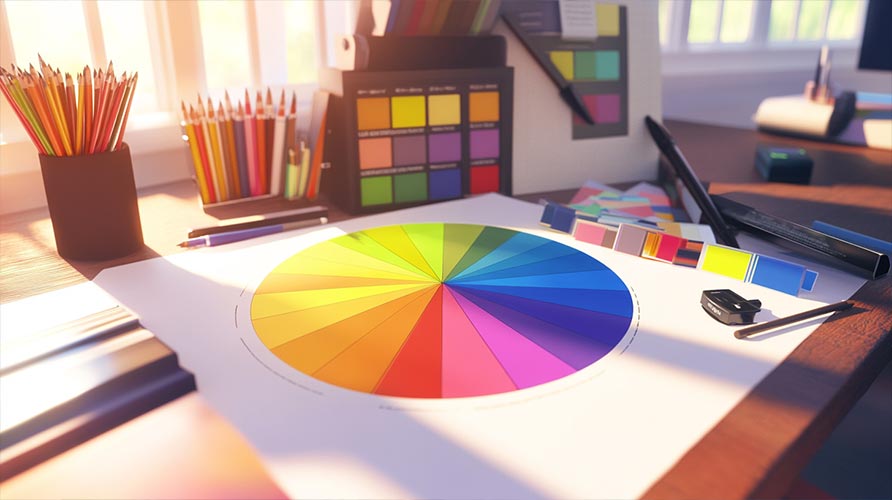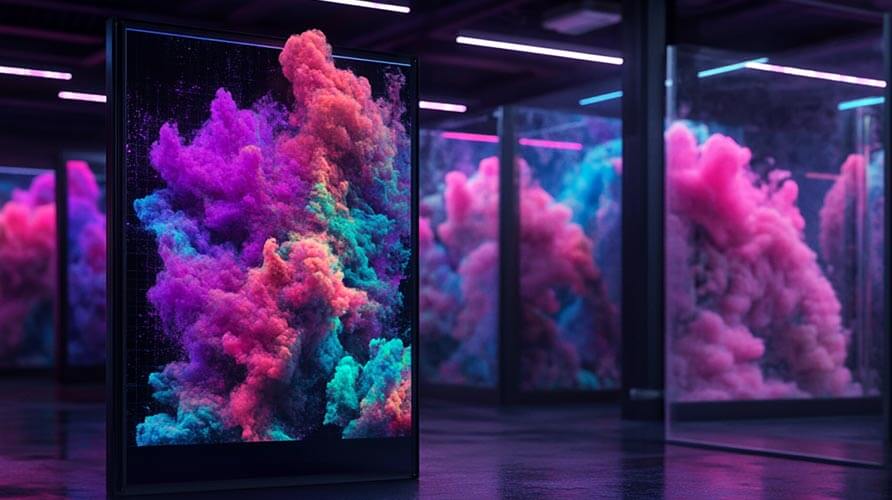The world of color is undergoing a profound transformation, driven by advances in artificial intelligence. From the way we select color palettes to how we predict color trends, AI is reshaping our relationship with color in ways that were unimaginable just a few years ago. This revolution extends beyond mere aesthetics—it's changing how brands communicate, how designers work, and how consumers experience color in their daily lives.
In this comprehensive exploration, we'll dive into the cutting-edge intersection of AI and color, examining how machine learning algorithms are creating new possibilities for color selection, combination, and application across industries.
The Evolution of Color Selection: From Intuition to Algorithm
For centuries, color selection was primarily guided by human intuition, cultural traditions, and established color theory principles. Artists and designers relied on their trained eyes and experience to create harmonious color combinations. While this approach produced remarkable results, it was inherently limited by human perception and subjective judgment.
The digital revolution brought color pickers and digital color wheels, making precise color selection more accessible. However, these tools still required significant human input and expertise to use effectively. The fundamental approach to color selection remained largely unchanged—until artificial intelligence entered the picture.
How AI is Transforming Color Selection
Today's AI-powered color tools represent a paradigm shift in how we approach color selection. Rather than simply digitizing traditional methods, these systems leverage vast datasets, complex algorithms, and machine learning to fundamentally reimagine the color selection process.
AI color systems can now:
- Analyze billions of color combinations to identify patterns that human designers might never discover
- Generate contextually appropriate palettes based on project requirements, target audience, and intended emotional impact
- Learn from user preferences to create personalized color recommendations
- Extract and refine color schemes from existing images with unprecedented precision
- Predict color trends by analyzing vast amounts of visual data across industries
These capabilities aren't just incremental improvements—they represent a fundamental shift in how we approach color selection, making sophisticated color decisions more accessible while opening new creative possibilities.
AI-Generated Color Palettes: Beyond Human Imagination
One of the most exciting developments in AI color technology is the ability to generate novel color palettes that might never occur to human designers. By analyzing millions of images, design samples, and user interactions, AI systems can identify unexpected color combinations that still maintain harmony and visual appeal.
Breaking Traditional Color Rules
Traditional color theory provides valuable guidelines for creating harmonious combinations, but it can also constrain creativity. AI-powered systems are now challenging these constraints by identifying successful color combinations that break conventional rules.
For example, while traditional color theory might discourage combining certain hues due to perceived disharmony, AI analysis of successful designs has revealed that these "clashing" combinations can be highly effective in specific contexts. This is leading to more diverse and unexpected color palettes that still resonate with audiences.
Context-Aware Color Generation
Modern AI color systems don't just generate aesthetically pleasing combinations—they create palettes specifically tailored to particular contexts, industries, and objectives. These systems consider factors like:
- Industry-specific color conventions and expectations
- Target demographic preferences and cultural considerations
- Psychological impact and emotional objectives
- Brand identity and competitive differentiation
- Practical considerations like accessibility and legibility
This context-awareness ensures that AI-generated palettes aren't just visually appealing but strategically effective for their intended purpose.
Scroll to see how AI can create dynamic color experiences!
Predictive Color Trends: How AI is Forecasting the Future of Color
Color trend forecasting has traditionally been a blend of art and science, relying heavily on human experts who analyze cultural shifts, runway shows, art movements, and consumer behavior to predict upcoming color trends. While effective, this approach is limited by human capacity to process information and inherent subjective biases.
AI is revolutionizing color trend prediction by analyzing vastly more data points than any human could process, identifying subtle patterns and emerging trends with remarkable accuracy.
The Data Behind AI Color Predictions
AI trend forecasting systems analyze diverse data sources, including:
- Social media imagery across platforms like Instagram, Pinterest, and TikTok
- E-commerce product listings and their performance metrics
- Fashion runway collections from around the world
- Interior design publications and architectural photography
- Art gallery exhibitions and museum collections
- Consumer purchasing patterns across industries
- Search trends related to colors and design
By processing this vast array of visual and behavioral data, AI systems can identify emerging color trends months or even years before they become mainstream, giving designers and brands a significant competitive advantage.
Digital Sage
A calming, nature-inspired green with digital undertones
Ambient Peach
A warm, inclusive neutral with technological sophistication
Hyper Blue
An energetic blue signaling innovation and digital transformation
Optimist Yellow
A vibrant yellow reflecting post-pandemic optimism
From Prediction to Application
The value of AI color trend prediction extends beyond simply knowing what colors will be popular. These systems can also recommend how to apply emerging color trends in specific contexts, considering factors like:
- How to incorporate trending colors into existing brand palettes
- Which color combinations will maximize the impact of trending hues
- How to adapt trends for different market segments and demographics
- The optimal timing for introducing trend-influenced designs
This practical guidance helps brands and designers leverage color trends effectively while maintaining their unique identity and objectives.
AI Color in Industry Applications
The AI color revolution is transforming practices across multiple industries, each with its unique applications and benefits.
Fashion and Apparel
In fashion, AI color systems are helping designers create seasonally relevant collections, predict color trends up to two years in advance, and develop color stories that resonate with target demographics. These tools are particularly valuable for fast fashion brands that need to quickly respond to emerging trends.
AI is also enabling more sustainable color practices by optimizing dye formulations, reducing waste, and helping brands maintain color consistency across global supply chains—a historically challenging aspect of apparel production.
Interior Design and Architecture
AI color tools are transforming interior spaces by generating contextually appropriate color schemes based on factors like room function, lighting conditions, architectural style, and client preferences. These systems can visualize how colors will appear in specific spaces under different lighting conditions, reducing the need for physical samples and minimizing costly mistakes.
For commercial spaces, AI can recommend color schemes optimized for specific objectives—like increasing productivity in offices or encouraging longer visits in retail environments—based on research-backed color psychology principles.
Digital Product Design
In UI/UX design, AI color systems are helping create more effective, accessible, and emotionally resonant digital experiences. These tools can generate interface color schemes that balance brand identity, user preferences, accessibility requirements, and psychological impact.
AI is also enabling more sophisticated personalization of digital experiences, with some platforms now dynamically adjusting color schemes based on individual user preferences, behavior patterns, and even environmental factors like time of day.
Traditional Color Selection
- Relies primarily on designer intuition and experience
- Limited by human perception and cognitive biases
- Typically considers a handful of variables
- Often follows established color theory rules
- Difficult to quantify effectiveness
- Time-intensive process requiring specialized expertise
- Static color schemes that remain fixed once implemented
AI-Powered Color Selection
- Analyzes vast datasets to identify optimal solutions
- Transcends human perceptual limitations
- Considers hundreds of variables simultaneously
- Discovers novel combinations beyond traditional rules
- Provides measurable performance metrics
- Automates complex decisions in seconds
- Enables dynamic, adaptive color schemes
The Ethical Considerations of AI Color Technology
As with any powerful technology, AI color systems raise important ethical considerations that designers, developers, and users must address. These include:
Cultural Sensitivity and Inclusivity
AI systems trained primarily on Western design traditions may perpetuate cultural biases in color selection. Developers must ensure these systems incorporate diverse cultural perspectives on color meaning and aesthetics. This requires training datasets that represent global design traditions and cultural contexts.
Additionally, AI color systems must consider accessibility needs, ensuring that generated color schemes work for users with various forms of color vision deficiency and other visual impairments.
Transparency in AI-Generated Recommendations
As AI color systems become more sophisticated, there's a risk that designers may over-rely on algorithmic recommendations without understanding the reasoning behind them. Ethical AI color tools should provide transparency about how recommendations are generated and what factors influence the suggested palettes.
This transparency helps designers make informed decisions about when to follow AI recommendations and when human judgment should take precedence.
Preserving Human Creativity
Perhaps the most significant ethical consideration is ensuring that AI color tools enhance rather than replace human creativity. The most effective implementations position AI as a collaborative partner that expands creative possibilities rather than an automated replacement for human design decisions.
This collaborative approach preserves the irreplaceable human elements of design—intuition, emotional intelligence, and cultural context—while leveraging AI's analytical capabilities.
The Future of AI and Color
Looking ahead, several emerging trends promise to further transform the relationship between AI and color:
Neurologically-Informed Color AI
Future AI color systems will likely incorporate more sophisticated understandings of how the human brain processes and responds to color. By integrating findings from neuroscience and cognitive psychology, these systems will create color experiences that more effectively engage with human perception and emotion.
Real-Time Adaptive Color
Emerging technologies will enable color schemes that adapt in real-time to changing contexts, user states, and environmental conditions. Imagine digital interfaces that subtly shift their color schemes based on the time of day, user behavior patterns, or even biometric indicators of the user's emotional state.
Cross-Modal Color Intelligence
Advanced AI systems are beginning to understand relationships between color and other sensory experiences, like sound, texture, and even taste. This cross-modal understanding will enable more sophisticated applications of color psychology, creating multi-sensory experiences where color works in harmony with other elements.
Democratized Color Expertise
As AI color tools become more accessible, sophisticated color decision-making will no longer be limited to trained designers. This democratization will enable individuals and small businesses to leverage color psychology effectively, potentially transforming how we communicate visually across digital and physical spaces.
Conclusion
The AI color revolution represents one of the most exciting frontiers in design technology. By combining the analytical power of artificial intelligence with the psychological impact of color, these systems are creating new possibilities for how we experience and interact with the visual world.
For designers, marketers, and brands, understanding and leveraging these technologies will be increasingly essential in creating effective visual experiences. The most successful approaches will balance AI's analytical capabilities with human creativity and ethical considerations, using technology to enhance rather than replace the human elements of design.
As we look to the future, the relationship between AI and color will continue to evolve, opening new creative possibilities and transforming how we communicate through visual design. Those who understand this revolution will be positioned to create more impactful, emotionally resonant, and effective color experiences in an increasingly visual world.



